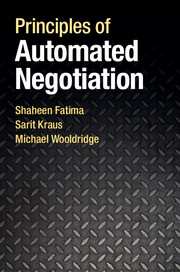Book contents
- Frontmatter
- Dedication
- Contents
- List of illustrations
- Preface
- Acknowledgements
- Summary of key notation
- 1 Introduction
- 2 Games in normal form
- 3 Games in extensive form
- 4 Negotiation domains
- 5 Strategic analysis of single-issue negotiation
- 6 Strategic analysis of multi-issue negotiation
- 7 The negotiation agenda
- 8 Multilateral negotiations
- 9 Heuristic approaches
- 10 Man–machine negotiations
- 11 Axiomatic analysis of negotiation
- 12 Applications
- 13 Related topics
- 14 Concluding remarks
- Appendix A Proofs
- References
- Index
10 - Man–machine negotiations
Published online by Cambridge University Press: 05 November 2014
- Frontmatter
- Dedication
- Contents
- List of illustrations
- Preface
- Acknowledgements
- Summary of key notation
- 1 Introduction
- 2 Games in normal form
- 3 Games in extensive form
- 4 Negotiation domains
- 5 Strategic analysis of single-issue negotiation
- 6 Strategic analysis of multi-issue negotiation
- 7 The negotiation agenda
- 8 Multilateral negotiations
- 9 Heuristic approaches
- 10 Man–machine negotiations
- 11 Axiomatic analysis of negotiation
- 12 Applications
- 13 Related topics
- 14 Concluding remarks
- Appendix A Proofs
- References
- Index
Summary
So far in the book, we have been focusing on situations in which all the negotiating participants are software agents. However, there are many applications where automated negotiators should be able to interact proficiently and collaborate with people. Automated negotiators can be used with humans in the loop or without them. When used with humans, they can alleviate some of the effort required of people during negotiations and can assist people less qualified in the negotiation process (Kersten and Lai, 2007). Also, there may be situations in which automated negotiators can even replace human negotiators (Durenard, 2013). Another possibility is for people embarking on important negotiation tasks to use these agents as a training tool, prior to actually performing the task (Lin et al., 2014). For example, automated negotiators in e-commerce applications can bargain over a price with their site's buyers (Kauppi et al., 2013). Personalised agents that support their users can negotiate with humans with conflicting preferences towards deciding on a meeting time (Tambe, 2008). They can also negotiate the formation of a “care plan” for patients requiring a course of medical treatment (Amir et al., 2013). A person who is preparing for a job interview can train herself with an agent that plays the role of the employer (Lin et al., 2009).
- Type
- Chapter
- Information
- Principles of Automated Negotiation , pp. 176 - 191Publisher: Cambridge University PressPrint publication year: 2014



